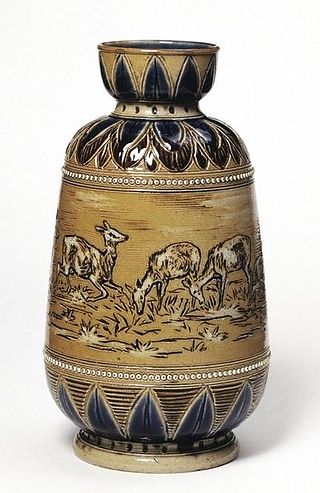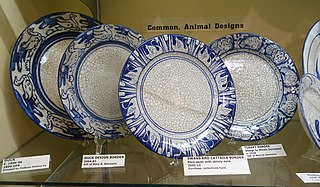
Fiesta is a line of ceramic glazed dinnerware manufactured and marketed by the Fiesta Tableware Company of Newell, West Virginia since its introduction in 1936, with a hiatus from 1973 to 1985. Fiesta is noted for its Art Deco styling and its range of often bold, solid colors.
North Dakota in the United States has been the scene of modern era pottery production using North Dakota clays since the early 1900s. In 1892 a study was published by Earle Babcock, a chemistry instructor at the University of North Dakota (UND) that reported on the superior qualities of some of the North Dakota clays for pottery production. The UND School of Mines began operations in 1898 with Earle Babcock as director. With the assistance of several eastern potteries, pottery made from North Dakota clay was first displayed at the 1904 St. Louis World's Fair.

Royal Doulton is an English ceramic and home accessories manufacturer that was founded in 1815. Operating originally in Vauxhall, London, and later moving to Lambeth, in 1882 it opened a factory in Burslem, Stoke-on-Trent, in the centre of English pottery. From the start, the backbone of the business was a wide range of utilitarian wares, mostly stonewares, including storage jars, tankards and the like, and later extending to drain pipes, lavatories, water filters, electrical porcelain and other technical ceramics. From 1853 to 1901, its wares were marked Doulton & Co., then from 1901, when a royal warrant was given, Royal Doulton.

Frederick Hurten Rhead (1880–1942) was a ceramicist and a major figure in the Arts and Crafts movement. A native of England, he worked as a potter in the United States for most of his career. In addition to teaching pottery techniques, Rhead was highly influential in both studio and commercial pottery. He worked for the Roseville Pottery, established his own Rhead Pottery (1913–1917), and in 1935 designed the highly successful Fiesta ware for Homer Laughlin China Company.

Mintons was a major company in Staffordshire pottery, "Europe's leading ceramic factory during the Victorian era", an independent business from 1793 to 1968. It was a leader in ceramic design, working in a number of different ceramic bodies, decorative techniques, and "a glorious pot-pourri of styles - Rococo shapes with Oriental motifs, Classical shapes with Medieval designs and Art Nouveau borders were among the many wonderful concoctions". As well as pottery vessels and sculptures, the firm was a leading manufacturer of tiles and other architectural ceramics, producing work for both the Houses of Parliament and United States Capitol.
The Fiesta Tableware Company is a ceramics manufacturer located in Newell, West Virginia, United States. Established in 1871, it is widely known for its Art Deco glazed dinnerware line, Fiesta. In 2002, The New York Times called Fiesta "the most collected brand of china in the United States".
The Overbeck sisters were American women potters and artists of the Arts and Crafts Movement who established Overbeck Pottery in their Cambridge City, Indiana, home in 1911 with the goal of producing original, high-quality, hand-wrought ceramics as their primary source of income. The sisters are best known for their fanciful figurines, their skill in matte glazes, and their stylized designs of plants and animals in the Art Nouveau and Art Deco styles. The women owned and handled all aspects of their artistic enterprise until 1955, when the last of the sisters died and the pottery closed. As a result of their efforts, the Overbecks managed to become economically independent and earned a modest living from the sales of their art.

Frankoma Pottery is an American pottery company located in Glenpool, Oklahoma, but originating in Sapulpa, Oklahoma. The company is known for its sculptures and dinnerware although the company made many other products including figurines, trivets, and vases. All Frankoma pottery is made in the US from locally excavated clay.

J.A. Bauer Pottery is an American pottery that was founded in Paducah, Kentucky in 1895 and operated for most of its life in Los Angeles, California. It closed in 1962.

Heath Ceramics is a B Corp certified American company that designs, manufactures, and retails goods for tabletop and home, and is best known for handcrafted ceramic tableware and architectural tile in distinctive glazes.

Dedham Pottery was an American art pottery company opened by the Robertson Family in Dedham, Massachusetts during the American arts & crafts movement that operated between 1896 and 1943. It was known for its high-fire stoneware characterized by a controlled and very fine crackle glaze with thick cobalt border designs. The Chelsea Keramic Art Works (1872–1889) and "Chelsea Pottery U.S." were earlier companies of the family.

Franciscan Ceramics are ceramic tableware and tile products produced by Gladding, McBean & Co. in Los Angeles, California, US from 1934 to 1962, International Pipe and Ceramics (Interpace) from 1962 to 1979, and Wedgwood from 1979 to 1983. Wedgwood closed the Los Angeles plant, and moved the production of dinnerware to England in 1983. Waterford Glass Group plc purchased Wedgwood in 1986, becoming Waterford Wedgwood. KPS Capital Partners acquired all of the holdings of Waterford Wedgwood in 2009. The Franciscan brand became part of a group of companies known as WWRD, an acronym for "Wedgwood Waterford Royal Doulton." WWRD continues to produce the Franciscan patterns Desert Rose and Apple.

Catalina Pottery is the commonly used name for Catalina Clay Products, a division of the Santa Catalina Island Company, which produced brick, tile, tableware and decorative pottery on Santa Catalina Island, California. Catalina Clay Products was founded in 1927. Gladding, McBean & Co. acquired all of the assets of the company in 1937 and moved all production to its Franciscan dinnerware division in Los Angeles.

Pacific Clay Products, founded 1892, was created by the merger of several Southern California potteries in the US. The company began producing utilitarian pottery in the 1920s, and introduced solid color earthenware dinnerware in 1932. The primary site for the production of ceramic tableware, kitchenware, and art ware was based in the company's Lincoln Heights, Los Angeles plant at 306 West Avenue 26. Pacific Clay ceased production of ceramic dinnerware and art ware in 1942. After 1942, Pacific Clay produced sewer tile and brick. The company ceased production of sewer tile in 1997. The company continues to produce brick products in Lake Elsinore, California. The company has been owned by David H. Murdock since 1973.

Vernon Kilns was an American ceramic company in Vernon, California, US. In July 1931, Faye G. Bennison purchased the former Poxon China pottery renaming the company Vernon Kilns. Poxon China was located at 2300 East 52nd Street. Vernon produced ceramic tableware, art ware, giftware, and figurines. The company closed its doors in 1958.

The Shawnee Pottery Company was a manufacturing company best known for producing Corn King pottery and the Pennsylvania Dutch lines of pottery. Both of these lines are considered highly collectible.
Charles John Noke, was an English pottery designer and artist who primarily worked for Royal Doulton.

Brayton Laguna Pottery produced ceramics (pottery) in Laguna Beach, California from 1927 to 1968.

American art pottery refers to aesthetically distinctive hand-made ceramics in earthenware and stoneware from the period 1870-1950s. Ranging from tall vases to tiles, the work features original designs, simplified shapes, and experimental glazes and painting techniques. Stylistically, most of this work is affiliated with the modernizing Arts and Crafts (1880-1910), Art Nouveau (1890–1910), or Art Deco (1920s) movements, and also European art pottery.
Kay Hackett was an artist and ceramic designer most known for her work for Stangl Pottery.















